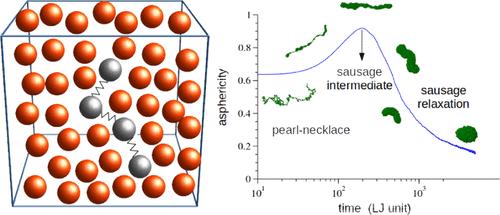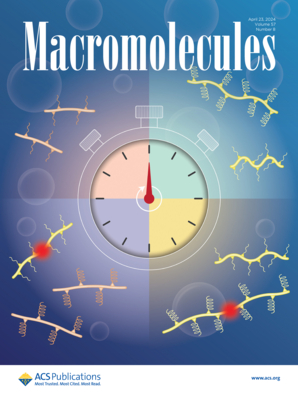温度和粘度调节聚合物崩解过程中的中间产物
IF 5.2
1区 化学
Q1 POLYMER SCIENCE
引用次数: 0
摘要
溶液中聚合物链的动力学会受到温度和溶剂粘度产生的摩擦力的显著影响。在此,我们利用可自由调节系统粘滞阻力的聚合物模拟显式溶剂框架,研究了柔性均聚物从良好溶剂条件下的延伸无规卷绕状态突然淬火到不良溶剂条件下的非平衡动力学。大量模拟结果表明,根据温度 T 和粘滞阻力的不同,在通常的珍珠项链中间体之后,会出现长寿命的香肠状中间体。利用聚合物的形状因子,我们将整个塌缩过程的这两个不同阶段区分开来。这样,我们就可以提取出相应的弛豫时间以及它们各自作为聚合物长度函数的缩放行为。香肠阶段是整个塌缩过程的限速阶段,其弛豫时间 τs 在高 T 极限遵循反阿伦尼斯行为,而在低 T 极限遵循阿伦尼斯行为。此外,τs 随粘滞阻力的变化提供了聚合物内摩擦的证据,这种内摩擦会显著调节整体塌缩,这与蛋白质在折叠过程中的弛豫速率类似。这表明,蛋白质中内摩擦力的来源可能是其聚合物骨架的固有特性,而非其他规格。本文章由计算机程序翻译,如有差异,请以英文原文为准。

Temperature and Viscosity Tune the Intermediates during the Collapse of a Polymer
Dynamics of a polymer chain in solution gets significantly affected by the temperature and frictional forces arising due to viscosity of the solvent. Here, using an explicit solvent framework for polymer simulation with the liberty to tune the viscous drag of the system, we study the nonequilibrium dynamics of a flexible homopolymer when it is suddenly quenched from an extended random-coil state in good solvent to poor solvent conditions. Results from our extensive simulations reveal that depending on the temperature T and viscous drag, one encounters long-lived sausage-like intermediates following the usual pearl-necklace intermediates. Using shape factors of the polymer we disentangle these two distinct stages of the overall collapse process. This allows us to extract the corresponding relaxation times and their respective scaling behaviors as a function of the length of the polymer. The relaxation time τs of the sausage stage, which is the rate-limiting stage of the overall collapse process, follows an anti-Arrhenius behavior in the high-T limit, and the Arrhenius behavior in the low-T limit. Furthermore, the variation of τs with the viscous drag provides evidence of internal friction of the polymer, that modulates the overall collapse significantly, analogous to what is observed for relaxation rates of proteins during their folding. This suggests that the origin of internal friction in proteins is plausibly intrinsic to its polymeric backbone rather than other specifications.
求助全文
通过发布文献求助,成功后即可免费获取论文全文。
去求助
来源期刊

Macromolecules
工程技术-高分子科学
CiteScore
9.30
自引率
16.40%
发文量
942
审稿时长
2 months
期刊介绍:
Macromolecules publishes original, fundamental, and impactful research on all aspects of polymer science. Topics of interest include synthesis (e.g., controlled polymerizations, polymerization catalysis, post polymerization modification, new monomer structures and polymer architectures, and polymerization mechanisms/kinetics analysis); phase behavior, thermodynamics, dynamic, and ordering/disordering phenomena (e.g., self-assembly, gelation, crystallization, solution/melt/solid-state characteristics); structure and properties (e.g., mechanical and rheological properties, surface/interfacial characteristics, electronic and transport properties); new state of the art characterization (e.g., spectroscopy, scattering, microscopy, rheology), simulation (e.g., Monte Carlo, molecular dynamics, multi-scale/coarse-grained modeling), and theoretical methods. Renewable/sustainable polymers, polymer networks, responsive polymers, electro-, magneto- and opto-active macromolecules, inorganic polymers, charge-transporting polymers (ion-containing, semiconducting, and conducting), nanostructured polymers, and polymer composites are also of interest. Typical papers published in Macromolecules showcase important and innovative concepts, experimental methods/observations, and theoretical/computational approaches that demonstrate a fundamental advance in the understanding of polymers.
 求助内容:
求助内容: 应助结果提醒方式:
应助结果提醒方式:


